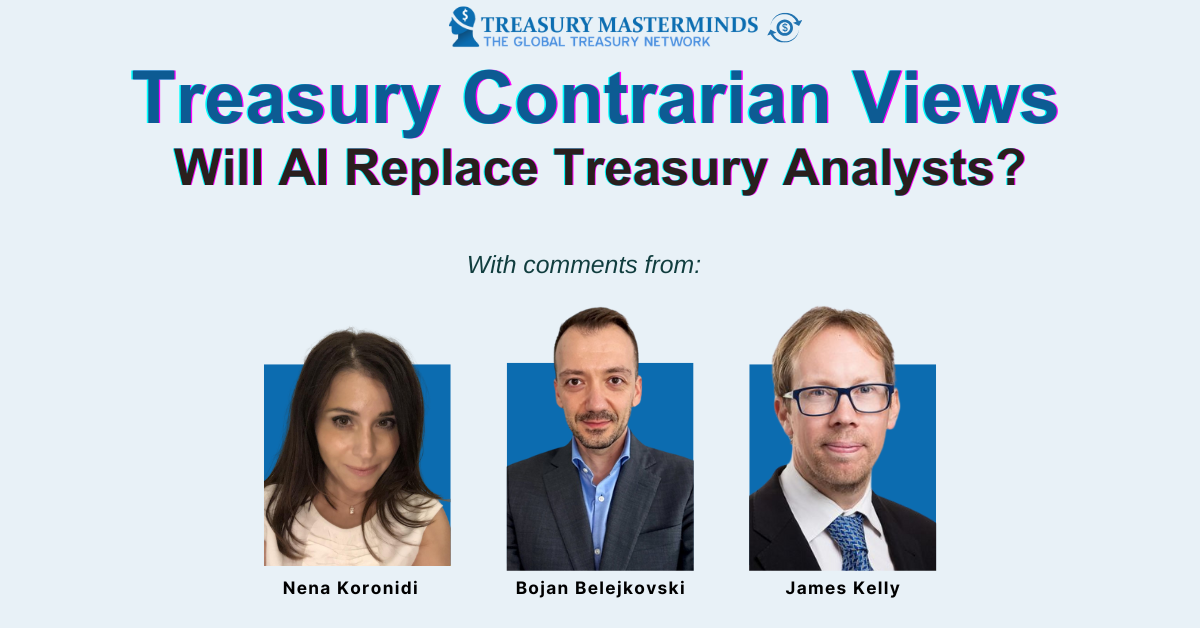
With the rise of artificial intelligence (AI) and automation, corporate treasury is experiencing a technological transformation. AI-driven forecasting, reconciliations, and fraud detection are becoming more advanced. But does this mean that the role of treasury analysts will soon be obsolete? Or is AI simply another tool to enhance efficiency rather than replace human expertise?
The Case for AI Taking Over Treasury Analyst Roles
- Superior Data Processing
- AI can analyze vast amounts of transactional data in real time, spotting patterns and anomalies faster than human analysts.
- Automated Cash Forecasting
- Machine learning algorithms continuously improve cash flow predictions, reducing reliance on manual spreadsheet analysis.
- Real-Time Risk Management
- AI-driven systems can detect fraudulent transactions, monitor FX risk, and adjust hedging strategies instantaneously.
- Efficiency and Cost Savings
- Companies can cut operational costs by replacing repetitive, manual treasury tasks with AI-powered automation.
The Case for Treasury Analysts Staying Relevant
- The Need for Human Judgment
- AI can process data, but interpreting complex financial decisions, market shifts, and strategic treasury moves still requires human insight.
- AI’s Dependence on Quality Data
- If AI models are fed incomplete or biased data, their predictions and insights could be flawed—requiring human oversight to validate accuracy.
- Relationship Management
- Treasury isn’t just about numbers; it involves negotiations, bank relationships, and internal stakeholder communication—areas where AI falls short.
- Regulatory Complexity
- Treasury professionals navigate ever-changing regulations, a task that requires adaptability, interpretation, and compliance expertise beyond AI capabilities.
The Future: AI as an Assistant, Not a Replacement
Rather than eliminating treasury analyst roles, AI is more likely to redefine them. The future of treasury will involve:
- AI handling repetitive and data-heavy tasks, allowing analysts to focus on strategy and decision-making.
- Treasury teams learning to work alongside AI, interpreting insights and applying business judgment.
- A shift from transactional roles to higher-value advisory positions within treasury.
Let’s Discuss
- Will AI ever fully replace treasury analysts, or will it simply change their responsibilities?
- Is your treasury team already using AI-driven solutions? If so, how has it impacted workflows?
- What skills should treasury professionals develop to stay relevant in an AI-driven environment?
We’ll be sharing insights from treasury leaders and industry experts—join the conversation and share your perspective!
COMMENTS

Nena Koronidi, Treasury Masterminds board member, comments:
AI will not replace treasury analysts; it will enhance their efficiency. Rather than spending hours in repetitive tasks, young treasury teams have the opportunity to focus on developing their decision-making and analytical skills much earlier in their careers. Instead of spending countless hours on data crunching and spreadsheets, they can focus on risk analysis and risk assessment and collaborating with senior members of the team to interpret the insights, ultimately becoming more valuable assets to the team. The transactional treasury role is long gone; this time, young treasury teams will be the ones driving the change.

Bojan Belejkovski, Treasury Masterminds board member, comments:
The future isn’t AI vs. Treasury teams—it’s treasury utilizing AI to drive better insights, efficiency, and value creation. Treasury teams that embrace AI as a tool, rather than a threat, will be best positioned for success.
While AI enhances forecasting, risk management, and general automation, it lacks the human judgment needed for strategic decision-making, relationship management, and navigating complex regulations specific to an organization.
Treasury is more than just data processing; it requires business acumen, adaptability, and financial expertise.

James Kelly, Treasury Masterminds board member, comments:
If all you do is press buttons, be worried.
If you’re curious, open minded and collaborative you’ll always have a role
AI opens the door to fixing the gaps in systems that have required a lot of manual intervention. Many of these vary from company to company and so require a degree of problem solving and creativity, but doing so will allow more time for strategy and supporting the business
AI only works off historic data and so will not be able to accurately predict in the event of a major shock which would require human judgement
Equally an AI-only treasury future is also a more unstable future – imagine if all were trained to fully draw loan facilities in the event of market disruption, we’d see more bank runs. AI also makes errors and so again imagine if a major trade was entered incorrectly- it may result in a loss for that company but may also trigger disruption in the market. A skilled analyst knows not to trade $200m via a trading portal asking 10 banks – AI may not
AI isn’t homogenous. There will be well trained effective AI and bad AI. At this stage we don’t yet know if good AI will eventually be able to replace analysts entirely – at present it can’t as the error/hallucination rate is way too high and we don’t know if all the data silo challenges can be resolved (which will probably vary by company), and that’s before thinking about the people side of things. Because people don’t make decisions solely based on data – data informs decisions but people make decisions based on emotion and connections.
Also Read
- Treasury Contrarian View: Treasury Dashboards — Are We Tracking the Wrong Metrics?
- Treasury Contrarian View: Payments in Crypto—A Treasury Reality or Just Noise?
- Treasury Contrarian View: Should Treasury Be a Profit Center?
- Treasury Contrarian View: The Case Against In-House Banks
- Treasury Contrarian View: ESG in Treasury—A Passing Trend or the Future?
- Treasury Contrarian View: Do We Really Need Treasury Centers in Every Region?
- Treasury Contrarian View: AI in Treasury—Hype or Reality?
- Trends Transforming the Current Treasury Management System (TMS) Landscape
- Treasury Contrarian View: Are Treasury Certifications Still Worth It?
- Treasury Contrarian View: Treasury Without Borders—Should Treasury Teams Go 100% Remote?
- Treasury Contrarian View: Why Stop at 100% Hedging?
- Treasury Contrarian View: Banks vs. Fintechs – Should Treasurers Bet on Smaller Players?
Join our Treasury Community
Treasury Mastermind is a community of professionals working in treasury management or those interested in learning more about various topics related to treasury management, including cash management, foreign exchange management, and payments. To register and connect with Treasury professionals, click [HERE] or fill out the form below to get more information.